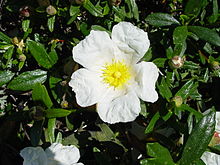| Labdan[S 1] | |
| Strukturformel | 
|
| CAS-Nummer | 561-90-0 |
| PubChem | 9548711 |
| Summenformel | C20H38 |
| Molare Masse | 278,5 g·mol−1 |
Die Labdane, oder auch Labdan-Diterpene, sind eine Stoffgruppe organisch-chemischer Verbindungen, aufgebaut aus natürlichen, bicyclischen Diterpenen. Ihr Grundgerüst, das Labdan, kommt in einer großen Vielfalt an Pflanzen vor, darunter in Salvia sp.,[1] Plectranthus sp.[2] und Andrographis paniculata.[3]

Labdane bestehen aus einem Decalingerüst, mit vier Methylgruppen und einem 3-Methylpentylrest. Sie sind nach der ersten gefundenen chemischen Verbindung ihrer Klasse benannt, dem Labdan, welches aus Labdanum, einem Harz der Lack-Zistrose (Cistus ladanifer), gewonnen werden kann.[4][5] Labdane weisen eine Vielzahl an biologischen Aktivitäten auf, unter anderem antibakterielle, antifungale und antiprotozoale Aktivität. Sie können zudem entzündungshemmend wirken[6] und sind oft auch Duftstoffe.
Beispiele von Labdanen
BearbeitenLiteratur
Bearbeiten- J. R. Hanson: Diterpenoids of terrestrial origin. In: Natural product reports. Band 34, Nummer 10, Oktober 2017, S. 1233–1243, doi:10.1039/c7np00040e, PMID 28875214.
Einzelnachweise
Bearbeiten- ↑ M. Akaberi, S. Mehri, M. Iranshahi: Multiple pro-apoptotic targets of abietane diterpenoids from Salvia species. In: Fitoterapia. Band 100, Januar 2015, S. 118–132, doi:10.1016/j.fitote.2014.11.008, PMID 25447154.
- ↑ S. Waldia, B. C. Joshi, U. Pathak, M. C. Joshi: The genus Plectranthus in India and its chemistry. In: Chemistry & biodiversity. Band 8, Nummer 2, Februar 2011, S. 244–252, doi:10.1002/cbdv.201000048, PMID 21337498.
- ↑ L. S. Chua: Review on liver inflammation and antiinflammatory activity of Andrographis paniculata for hepatoprotection. In: Phytotherapy research : PTR. Band 28, Nummer 11, November 2014, S. 1589–1598, doi:10.1002/ptr.5193, PMID 25043965.
- ↑ J. D. Cocker, T. G. Halsall, A. Bowers: The chemistry of gum labdanum. I. Some acidic constituents. In: Journal of the Chemical Society. 1956, S. 4259–4262, doi:10.1039/JR9560004259.
- ↑ J. D. Cocker, T. G. Halsall: The chemistry of gum labdanum. II. The structure of labdanolic acid. In: Journal of the Chemical Society. 1956, S. 4262–4271, doi:10.1039/JR9560004262.
- ↑ A.-U. Rahman: Studies in Natural Product Chemistry : Bioactive Natural Products, Part F. ISBN 978-0-08-044001-9.